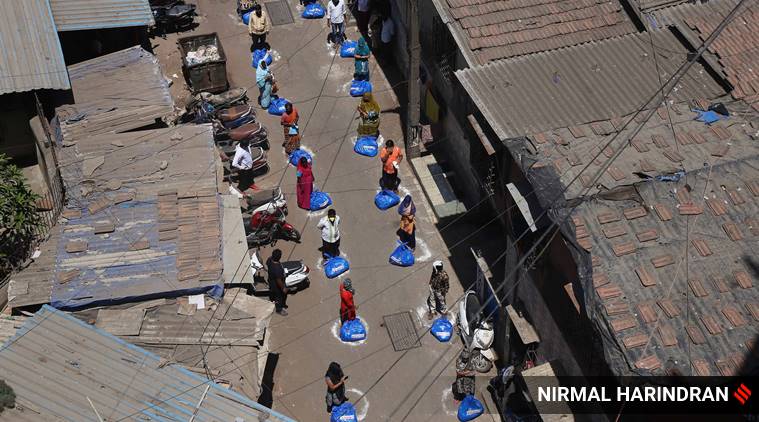 Residents stand in line following social distancing as an NGO distributes ration packets in Mumbai’s Dharavi.
Residents stand in line following social distancing as an NGO distributes ration packets in Mumbai’s Dharavi.
Written by Ruchira Bhattacharya
COVID-19 pandemic has claimed thousands of lives. Many preventive measures have been suggested to contain the pandemic, but what has stuck most is “social distancing”. This extreme citizen-driven prevention measure, where people choose to isolate themselves to stop the spread of the virus, is now being prescribed by governments everywhere.
In India, disease control measures have so far been strict, starting with intensive screening at entry points, mass-awareness campaigns through various media channels and, finally, a nation-wide lockdown.
But over the last few days, the attitude around disease prevention, both in society and the media, has shifted to an aggressive approach where the practice of social distancing is being projected as a moral burden for all citizens. There are reports of service providers at various levels mistreating patients, the panic of “untouchability” among those who are showing symptoms, and social condemnation of those failing to “isolate” themselves that has an eerie resemblance to society’s attitude towards HIV-positive patients. Patients fleeing from the authorities is a manifestation of this panic of social discrimination.
The question is, how realistic is the idea of social distancing in this country? There is a certain middle-class romanticism around the idea, fueled by heart-wrenching stories such as the 6 pm songs from the balconies in Italy, but this push to enforce lockdown, no matter how effective, needs to be informed by a few realities of our country.
The first and foremost requirement of distancing is space. On that front, India has little scope to separate its people. In a country with around 240 million households, 18.78 million houses are in congested areas. With an average of 4.7 members per household, more than three in five in India live in structures with less than two rooms and one in three live in one room or less. In urban India, which is the target for the lockdown, 17 per cent of the population lives in slums.
The risk of contamination and spread does not end with the availability and distribution of housing. Access to exclusive toilets in India is low. Although the cites are declared “Open Defecation Free”, many people use community toilets in urban areas and share the sources of water for cleaning and drinking. Only 51 per cent of all urban wards have solid waste processing in place.
We must also remember that the realities of “stay-at-home” are very different for those who do not have a regular occupation with a stable income. A section of India’s workforce will go hungry as they are “locked down”, and have no livelihood.
Listing the challenges, however, is in no way an effort to undermine the importance of distancing. But, we must acknowledge that a serious need of the hour is the extension of improved health services for all. Despite having a well-defined structure of the healthcare system, India’s preparedness for a pandemic-like situation is far from enough: Just 1.6 per cent of the budget is allocated to healthcare – one of the lowest globally — and 80 per cent of India’s total out-patient and 60 per cent of in-patient care providers are private. Further, only 58 per cent of patients use such services. Due to a pro-rich and pro-urban inequality in the health-budget allocation, out-of-pocket expenditure has shown a higher increase among the poor who are the most vulnerable to exposure and infections.
There is huge inequality in the hospital-to-population ratio ranging from 1:100,000 in Delhi to 55:100,000 in Arunachal Pradesh. Conditions of healthcare facilities are poor with insufficient infrastructure, staff, low sanitation and disposal. An estimated three million beds are still needed for India to achieve the target of three beds per 1,000 people by 2025. Even with several regulatory acts in place, incidents such as the 2011 fire in a high-end private hospital in West Bengal killing 89 people have happened.
Despite these challenges, there is hope. India achieved the WHO-recommended doctor-to-population ratio in 2018. The National Health Policy has planned to increase the health budget to 2.5 per cent of GDP by 2025.
There are reports of lockdown-linked hunger, unemployment and community transmissions. With the already poor quality of healthcare, the risks of exclusion and negligence will become of primary concern in the near future. Lockdowns may work temporarily, but for long-term safety all the healthcare facilities of the country will have to be brought to a comparable level of performance so that an outbreak of this nature can be swiftly handled.
(The writer is assistant professor, National Institute of Rural Development and Panchayati Raj)